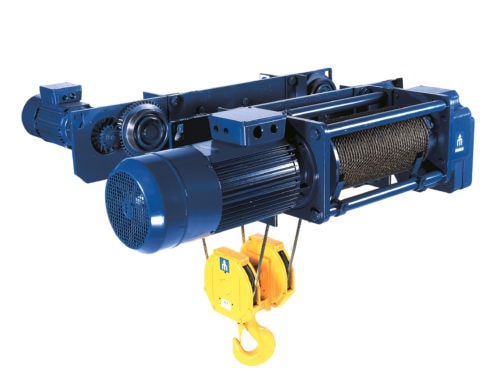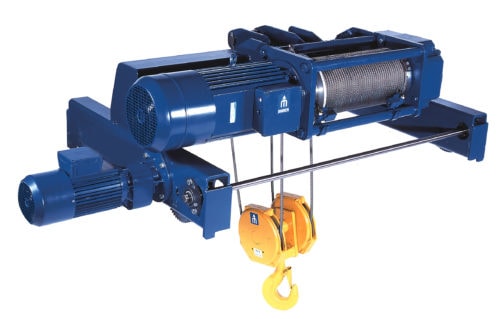Cranes are a type of material handling equipment used to facilitate the movement of bulky or heavy materials around industrial and commercial worksites. While they are available in many designs and configurations to suit different applications, they generally consist of the same four basic components. Each of these components serves a different function that, when combined with those of the other components, enables the crane assembly to lift and position loads as intended.
Below, we provide a more comprehensive overview of each of the four key crane components.
Parts of a Crane
Cranes consist of four key components:
1. Hook
 The hook element of a crane is the part that holds or carries the load and connects it to the hoisting element. Due to its function, it experiences a significant amount of wear during operations, which makes it one of the parts that need to be regularly replaced.
The hook element of a crane is the part that holds or carries the load and connects it to the hoisting element. Due to its function, it experiences a significant amount of wear during operations, which makes it one of the parts that need to be regularly replaced.
2. Hoist
The hoist element of a crane provides the vertical lifting and lowering power. Its lifting and lowering capacity is influenced by its design and construction. For example, chain hoists offer load capacities of ≤5 tons, while wire rope hoists offer load capacities of ≥5 tons. Similarly, hand-powered hoists are suitable for lighter loads, while electric-powered hoists are suitable for heavier loads.
Some cranes feature a main hoist and auxiliary hoist. The former is used to handle heavier loads at slower speeds, while the latter is used to handle lighter loads at faster speeds.
3. Trolley
 The trolley element of a crane provides the horizontal movement power. It is designed to move the hoist and hook components along a track or beam across the top (top-running trolleys) or bottom (bottom-running trolleys) of the bridge component.
The trolley element of a crane provides the horizontal movement power. It is designed to move the hoist and hook components along a track or beam across the top (top-running trolleys) or bottom (bottom-running trolleys) of the bridge component.
Some cranes feature bogies. These short end trucks allow for the placement of multiple wheels at each corner of the crane to ensure more even load distribution.
4. Bridge
The bridge element of a crane is the part that bears the weight of the load and the other crane components (e.g., hook, hoist, and trolley). It runs the entire length of the crane system, allowing the trolley and, consequently, the attached hoist and hook to move horizontally across the worksite.
The bridge consists of large horizontal structural beams—i.e., girders—supported by end trucks. The girders generally have a slight upward vertical curved—i.e., camber—to compensate for the deflection caused by the weight of the load and the other crane components. Depending on the load requirements, the bridge may have a single or double beam configuration. The rectangular cross-section of the girders, trucks, and other members, consisting of two rolled steel side plates and a top and bottom plate, is known as the box section.
ACECO: Your Expert, Craftsman, & Partner for Cranes, Hoists, and Other Material Handling Equipment
Cranes play an essential role in a variety of industrial and commercial applications. However, it is important to choose a design and configuration that accommodates the load and other work requirements of the job site. Otherwise, there is a risk of the unit failing and causing employee injury or equipment damage. If you need assistance selecting and sourcing a crane for your facility, ACECO has got you covered.
At American Crane & Equipment Corporation, we specialize in manufacturing standard and custom cranes, hoists, and other material handling equipment. Equipped with extensive industry experience and highly skilled engineers, we are the ideal expert, craftsman, and partner for all load lifting and positioning needs. To learn more about our products and services or discuss your equipment requirements with one of our team members, contact us or request a quote today.

